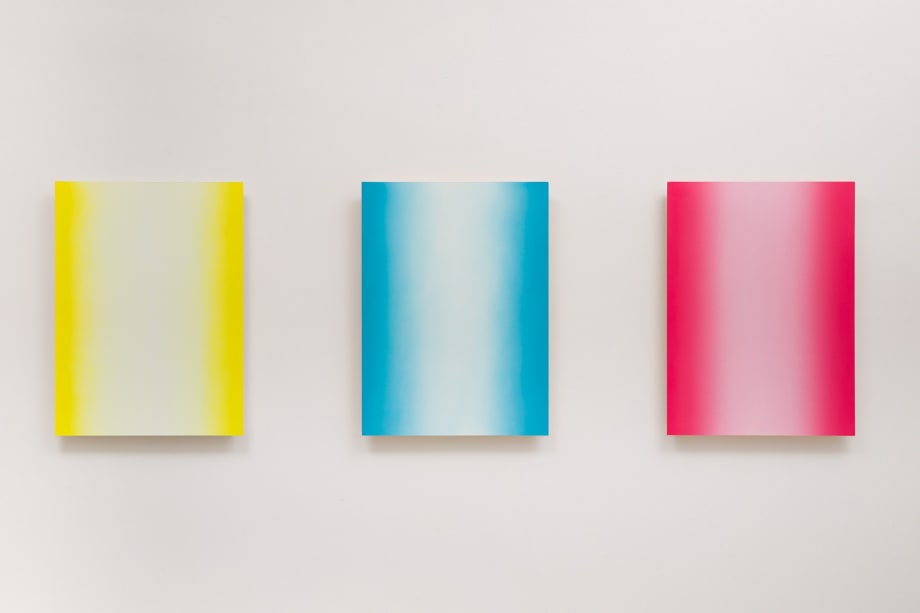Edward Cella Art & Architecture is proud to present 3 By 7 within Intersect 21, a new virtual set of exhibitions presenting artwork from twenty-one galleries hailing from California, the Middle East, and North Africa. The gallery’s participation in the debut edition of Intersect 21 provides the opportunity to exhibit three new and recent works by seven California artists whose practices converge at the intersection of art, culture, and design. The exhibition 3 by 7 highlights the distinctive and unique processes, technologies, and methodologies in the work of Kendell Carter, Alexander Kroll, Brad Miller, Patti Oleon, Ruth Pastine, Aili Schmeltz and Amir Zaki. Together, the twenty-one artworks offered propose new and unfamiliar points of view into and about the environment and cultures that help characterize contemporary artmaking in California.
Intersect 21 presents a focused, curated platform for cultural exchange. Galleries included will explore the notion of art and place, the creation of art in these specific regions, and the impact it has on their culture and society. Intersect 21 will take place from February 16–22, 2021 and continue on Artsy through March 15, 2021. There will be an invitation-only VIP preview February 16 from 12am - 12pm ET.
Sustaining a dedication to observing and exploring race, gender, history, and consumer culture, Kendell Carter pursues a practice acknowledging the rapidly integrating and shifting nature of today's visual cultures. Employing both sculpture and painting processes; Carter creates distinctive hybrid cast paintings incorporating the freehand gestures of graffiti made of aerosol spray, casting techniques, and an intuitive process-based method of making physical objects that emerge from difficult and uncertain conditions. In Carter’s words, “Art’s extraordinary strength is its ability to arrest and dissolve beliefs caused by linear thinking. Visual art uses iconography and gestures to create belief through seeing creating conditions in which heartfelt and tangible perceptions can shift.”
The abstract paintings by Alexander Kroll have been likened to novels. “There’s a patient yet mountainous layering to them. There is a litany of moods. Probably the most novelish thing about them is that they feel self-deterministic—one stroke determines the next, yet you don’t know where it’s headed.” A master of his medium, Kroll employs oil paints in a number of ways to construct the complex layers and interwoven visual fields that are a hallmark of his work. Densities of color, hue and value and other means are used to create sensual passages and compose the rich emotional tenor to his paintings. Though highly cognizant of the history of painting, Kroll creates compositions that reach out into the world and engage in life.
For more than five decades, Brad Miller has worked with clay, other sculptural mediums and photograms to explore the formal archetypes of organic systems for both their physical and conceptually aesthetic properties. Discovering interlocking biomorphic structures, spiraling forms, and cellular patterns through firing, torching, sanding, tumbling, and grinding processes, Miller physically interacts with fired clays in unique and distinct ways. Employing the methodologies of abstract expressionism and conceptualism, Miller orchestrates accidents to build his work that ultimately reveal lyrical and transformative patterns that evoke nature itself.
The mesmeric paintings of Patti Oleon simultaneously encourage and undermine expectations. Based in a series of photographs of apartment lobbies taken in a part of Los Angeles where she grew up, Oleon transforms these banal interstitial and transitory spaces into dense and layered compositions first using digital tools and then again through the meticulous process of creating her oil paintings. These compositions are an amalgam of incidents and real places dislocated in time and space, realistically rendered but on the verge of abstraction. Like a confounding fiction or film noir; the paintings present what appears to be factual, yet are rife with association, ambiguities, and transmutations. She discovers the disquiet in the midst of the mundaneness.
Ruth Pastine debut of her newest paintings suggest a shift in the work of the artist recognized for her minimalist color field paintings that challenge the phenomena of perception and the relativity of color, light and space. Works from the Presence Absence series created in the pressurized atmosphere of the past year and burn white hot with their heightened visual intensity. Like sunlight they arrest the perceptual ability of the viewer’s eyes yet demonstrate her control and mastery of her oil-based medium applied through countless small brush strokes. Evolving the Minimalist underpinning of her practice, Pastine reduces color and light to their most elemental creating works that are both objective and dematerialized.
The research-based practice of Aili Schmeltz often alludes to utopian ideologies that inform the development of the American West and the vast artificial environments of Southern California in particular. Her newest works combine painting, collage and sewing to create all together new hybrids which continue her fundamental investigation of pattern and form. Conflating notions of traditional “woman’s work” and the mark-making practices and monochromatic pallet of Minimalist painters; these wall-based sculptures dazzle in their subtle radiance and undulation of color. Underscoring the typological and spatial colonization that this series represents, each work is titled after one of the historical female homesteaders of the Mojave Desert –a landscape of that is both home to one of her studios and a source of fascination and inspiration.
Amir Zaki has dedicated himself to exploring the suburban landscape of California though his photographic practice often taken from unique points of view. His newest and most ambitious series to date, surveys a quintessential California architectural form, the concrete skatepark. Within two complementary bodies of work, Concrete Vessels and Broken Vessels; Zaki plumbs the tensions between solidity and fragility; intentional and accidental; monumental and minuscule and seeks to create compositions that he describes, “appear to be wholly instantaneous, yet reveal subtle clues regarding their extended temporality.” ECAA’s presentation coincides with an exhibition of excerpts of the series at the Museum of Art and History in Lancaster, CA on view through May 9, 2021.



